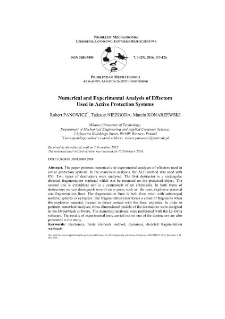Nasza Biblioteka Cyfrowa udostępnia 1 868 obiektów cyfrowych
Obiekt
Tytuł: Numerical and Experimental Analysis of EffectorsUsed in Active Protection Systems ; Numerical and Experimental Analysis of EffectorsUsed in Active Protection Systems
Tytuł odmienny:
Numeryczno-eksperymentalne analizy efektorów stosowanych w systemach obrony aktywnej ; Numeryczno-eksperymentalne analizy efektorów stosowanych w systemach obrony aktywnej
Współtwórca:
Tadeusz NIEZGODA, Marcin KONARZEWSKI ; Tadeusz NIEZGODA, Marcin KONARZEWSKI
Abstrakt:
The paper presents numerical and experimental analyses of effectors used in active protection systems. In the numerical analyses, the ALE method was used with FSI. Two types of destructors were analysed. The first destructor is a rectangular directed fragmentation warhead which can be mounted on the protected object. The second one is cylindrical and is a component of an antimissile. In both types of destructors we can distinguish several main parts, such as: the case, explosive material and fragmentation liner. The fragmentation liner is built from resin with submerged metallic spheres or cylinders. The fragmentation liner forms a cloud of fragments when the explosive material, located in direct contact with the liner, explodes. In order to perform numerical analyses, three-dimensional models of the destructors were designed in the HyperMesh software. The numerical analyses were performed with the Ls-Dyna software. The results of experimental tests carried out on one of the destructors are also presented in the study.
;
The paper presents numerical and experimental analyses of effectors used in active protection systems. In the numerical analyses, the ALE method was used with FSI. Two types of destructors were analysed. The first destructor is a rectangular directed fragmentation warhead which can be mounted on the protected object. The second one is cylindrical and is a component of an antimissile. In both types of destructors we can distinguish several main parts, such as: the case, explosive material and fragmentation liner. The fragmentation liner is built from resin with submerged metallic spheres or cylinders. The fragmentation liner forms a cloud of fragments when the explosive material, located in direct contact with the liner, explodes. In order to perform numerical analyses, three-dimensional models of the destructors were designed in the HyperMesh software. The numerical analyses were performed with the Ls-Dyna software. The results of experimental tests carried out on one of the destructors are also presented in the study.
Miejsce wydania:
Warszawa
;
Warszawa
Wydawca:
Wojskowa Akademia Techniczna ; Wojskowa Akademia Techniczna
Data utworzenia:
Data złożenia:
Data akceptacji:
Data wydania:
Rozmiar:
Identyfikator:
oai:ribes-88.man.poznan.pl:2291
Sygnatura:
DOI 10.5604/01.3001.0009.2984 ; DOI 10.5604/01.3001.0009.2984
ISSN elektroniczny:
ISSN drukowany:
Język:
Właściciel praw:
Wojskowa Akademia Techniczna ; Wojskowa Akademia Techniczna
Strona początkowa:
Strona końcowa:
Tom:
Słowa kluczowe:
mechanics, finite elements method, dynamics, directed fragmentation warheads ; mechanics, finite elements method, dynamics, directed fragmentation warheads
Kolekcje, do których przypisany jest obiekt:
Data ostatniej modyfikacji:
24 lip 2025
Data dodania obiektu:
24 lip 2025
Liczba wyświetleń treści obiektu:
0
Wszystkie dostępne wersje tego obiektu:
https://ribes-88.man.poznan.pl/publication/2591
Wyświetl opis w formacie RDF:
Wyświetl opis w formacie OAI-PMH:
| Nazwa wydania | Data |
|---|---|
| Numerical and Experimental Analysis of EffectorsUsed in Active Protection Systems | 24 lip 2025 |
Obiekty Podobne
Robert PANOWICZ Marcin KONARZEWSKI
Robert PANOWICZ Damian KOŁODZIEJCZYK, Kamil SYBILSKI, Tadeusz NIEZGODA

